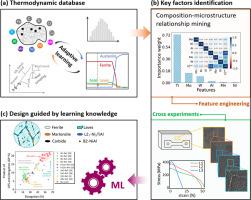Journal of Materials Science & Technology ( IF 10.9 ) Pub Date : 2023-06-01 , DOI: 10.1016/j.jmst.2023.04.034 Xiaobing Hu , Yiming Chen , Jianlin Lu , Chen Xing , Jiajun Zhao , Qingfeng Wu , Yuhao Jia , Junjie Li , Zhijun Wang , Jincheng Wang

|
15Cr ferrite steels are urgently required in advanced Ultra-supercritical power plants but meet design challenges in balancing excellent strength and plasticity at high temperatures. We developed a three-step learning strategy based on mutually driven machine learning and purposeful experiments to complete this multi-objective task. Compared with traditional adaptive learning and local-interpolation learning, this step-by-step modular manner provides good transparency and interpretability of the information flow, which is ensured by identifying essential factors from an exquisitely prepared composition-microstructure dataset, and learning valuable knowledge about the composition-property relationship. The requirement of only two groups of experiments indicates the low cost and high efficiency of the strategy. Performing the strategy, we found that Ti is another key element affecting the Laves phase besides Mo and W, and their effects on ultimate tensile strength (UTS) and elongation were also uncovered. Importantly, several low-cost steels free of Co were successfully designed, and the best steel exhibited 156%, 31%, and 62% higher UTS and elongation at 650°C than the typical 9Cr, 15Cr, and 20Cr steels, respectively. Based on the advantages and success of the strategy in terms of alloy improvement, we believe the strategy suits other multi-objective design tasks in more materials systems.
中文翻译:

设计高温强度和塑性增强的 15Cr 铁素体钢的三步学习策略
先进的超超临界发电厂迫切需要 15Cr 铁素体钢,但在平衡高温下优异的强度和塑性方面面临设计挑战。我们开发了一种基于相互驱动的机器学习和有目的的实验的三步学习策略来完成这项多目标任务。与传统的自适应学习和局部插值学习相比,这种循序渐进的模块化方式提供了良好的信息流透明度和可解释性,这是通过从精心准备的成分-微观结构数据集中识别基本因素,并学习有关的有价值知识来确保的。组成-性质关系。只需两组实验的要求表明该策略成本低、效率高。执行策略,我们发现 Ti 是除 Mo 和 W 之外影响 Laves 相的另一个关键元素,并且还揭示了它们对极限拉伸强度 (UTS) 和伸长率的影响。重要的是,成功设计了几种不含 Co 的低成本钢,其中最好的钢在 650°C 下的抗拉强度和延伸率分别比典型的 9Cr、15Cr 和 20Cr 钢高 156%、31% 和 62%。基于该策略在合金改进方面的优势和成功,我们相信该策略适用于更多材料系统中的其他多目标设计任务。在 650°C 下,UTS 和延伸率分别比典型的 9Cr、15Cr 和 20Cr 钢高 62%。基于该策略在合金改进方面的优势和成功,我们相信该策略适用于更多材料系统中的其他多目标设计任务。在 650°C 下,UTS 和延伸率分别比典型的 9Cr、15Cr 和 20Cr 钢高 62%。基于该策略在合金改进方面的优势和成功,我们相信该策略适用于更多材料系统中的其他多目标设计任务。



























 京公网安备 11010802027423号
京公网安备 11010802027423号